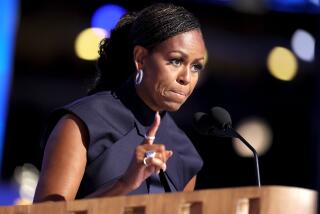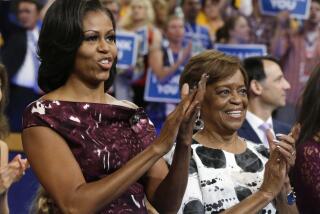First ladies must fill an ill-defined post
- Share via
WASHINGTON — Among the many challenges Michelle Obama will face as first lady, the biggest may be defining the job.
And therein lies the problem: Her newest high-profile job isn’t a job, per se.
The Founding Fathers made no provision for the first lady in the Constitution, and no formal or official description exists. The first lady is neither elected nor appointed, but comes along with the president, for better or worse.
Nor is she paid for all that’s required of her.
Many a first lady has said, in retrospect, that she had no idea how hard being first lady would be. Even the current one, Laura Bush, according to author and first lady historian Betty Caroli.
Of all the first ladies, she should have known what was in store: Her mother-in-law, Barbara, was first lady from 1989-1993.
“So no matter I suppose how well prepared . . . she’s probably going to be surprised by the enormity of the publicity, the focus, the demands and so forth,” Caroli said of Michelle Obama.
The first lady gets an office in the White House, typically the East Wing -- though Hillary Rodham Clinton caused a stir when she famously planted herself in the West Wing among the heavy-hitting honchos of her husband’s administration.
There’s also a staff to help plan and execute the many social functions held every year at the country’s most famous residence, and to help her promote her chosen causes.
Still, the job description is ill-defined, said Robert P. Watson, who has written two books about first ladies and directs the American studies program at Lynn University in Boca Raton, Fla.
“The first lady has to find her own way and match that with her husband’s interests,” Watson said.
So like most people in a loosely defined job, first ladies have made of it what they’ve made of it, from the traditionalists like Mamie Eisenhower and Bess Truman, to the politically active like Eleanor Roosevelt and Hillary Clinton.
First ladies have a certain freedom, then, but only to a point: For all the talk of the Obamas changing Washington, Michelle Obama, cannot, for instance, say “no” to presiding over the annual Easter Egg Roll, which dates to 1878.
Laura Bush once said she didn’t see herself as a certain type of first lady. “I view my role as first lady as Laura Bush,” she told the Dallas Morning News in November 2001. “I really do think that Americans want the first lady to do whatever it is she wants to do.”
And Laura Bush did. She started slow, with a focus on reading and education, befitting a former teacher and school librarian. But she became more politically active as the years passed.
Michelle Obama has said her first priority is to help her two young daughters make the adjustment to a new way of life.
“The primary focus for the first year will be making sure that the kids make it through the transition. But there are many issues that I care deeply about,” she told “60 Minutes,” singling out military families, work-family balance, education and the Washington community. “So there’s plenty to do.”
And to be criticized for.
All first ladies have met with criticism, usually for something they did, said or wore.
Michelle Obama has endured her share already. She still hasn’t lived down the moment when she seemed to suggest that she had not as an adult been proud of her country until she saw the public’s reaction to her husband’s candidacy.
Now she’ll be under the microscope with everyone watching, for example, her clothes, how she decorates the White House for Christmas and how much money she spends on this or that.
It’s all part of the balancing act for first ladies, who must tiptoe between being traditional and activist. Said Watson: “You can’t go out too far one way or the other.”
More to Read
Get the L.A. Times Politics newsletter
Deeply reported insights into legislation, politics and policy from Sacramento, Washington and beyond. In your inbox three times per week.
You may occasionally receive promotional content from the Los Angeles Times.










